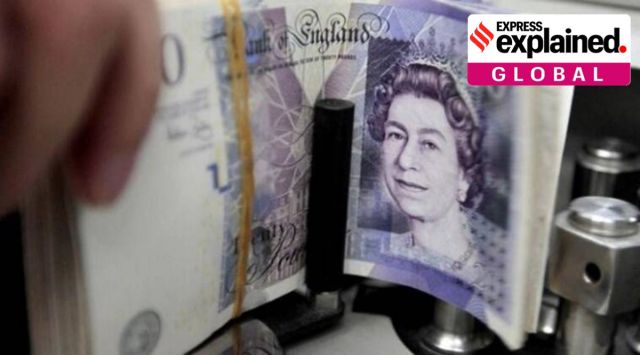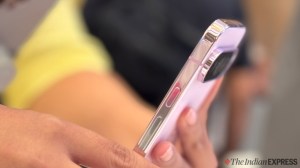Britain has a new monarch. Here’s how flags, currency, and its national anthem will change
Queen Elizabeth II dies: As she is laid to rest, several of the things that were associated with — and signified — her reign of more than 70 years will undergo changes.
 Queen Elizabeth II dies: Some 4.5 billion notes will have to be replaced. (Reuters Photo/File)
Queen Elizabeth II dies: Some 4.5 billion notes will have to be replaced. (Reuters Photo/File)The monarchy is an inalienable part of the national life of the United Kingdom, and the image, emblems, and the royal cypher of the monarch is intertwined intricately with the day-to-day lives of her subjects. As Queen Elizabeth II is laid to rest beside her husband Prince Philip at King George VI memorial chapel at Windsor Castle in Berkshire, several of the things that were associated with — and signified — her reign of more than 70 years will undergo changes.
Flags and standards across the UK
The royal cypher, ‘EIIR’, is emblazoned on flags that fly on innumerable official buildings and installations, including police stations across the UK and Royal Navy vessels under certain circumstances. The British military flies the “Queen’s Colours” of blue, red, and gold, and many flags carry the ‘EIIR’ in gold. The British National Fire Service Ensign carries her initials, and some Commonwealth countries of which the Queen was head of state, such as Australia and New Zealand, have an ‘E Flag’ that was approved by her and was used to denote her presence when she visited.
A report in The Guardian said it was possible that the Royal Standard, which is the quartered flag representing two quarters for England and a quarter each for Scotland and Ireland, could also change. The new monarch might decide to include a representation for Wales too.
The British National Anthem
The UK National Anthem has the words “God save our gracious Queen”, which will change to “God save our gracious King”, switching back to the traditional phrase “God Save the King”, which has been in use from at least the early 17th century. The current anthem has been sung since 1745, and originally contained the words “God save great George our king, Long live our noble king, God save the king.”
Despite being a straightforward change, however, it remains to be seen, as The Guardian pointed out, how readily the British public is able to make the shift from Queen to King while singing the anthem at large public gatherings.
Currency of the UK
British currency notes have the face of the Queen on them, and some 4.5 billion pound notes are currently in circulation, adding up to a total value of £ 80 billion. They will have to be replaced, and the process could take several years to be completed. The face of Queen Elizabeth has appeared on notes since 1960, and she also features in some other Commonwealth currencies. Some coins too feature her face, even though changing those might take longer than changing paper currency.
Post boxes in Britain
Royal Mail post boxes have the cypher of Queen Elizabeth, ‘ER’, which, according to reports in the British media, are likely to stay. The Guardian report pointed out that some post boxes with the ‘GR’ cypher of King George VI, the predecessor of Elizabeth II on the throne, are still in use today. Stamps used by the post offices will, however, change, and will be replaced by the face of the new monarch.
Pledges in Queen’s name
All British MPs must pledge allegiance to the Crown. They take the oath: “I…swear by almighty God that I will be faithful and bear true allegiance to Her Majesty Queen Elizabeth, her heirs and successors, according to law. So help me God.” That will now change. MPs in the Houses of Commons and Lords will swear oath to the new King, Charles.
Also, those who become citizens of the UK now swear to “bear true allegiance to Her Majesty Queen Elizabeth the second, her heirs and successors”. That too is likely to change, as will the oath taken in the name of the Queen by members of the armed forces and some other uniformed forces.



- 01
- 02
- 03
- 04
- 05



































